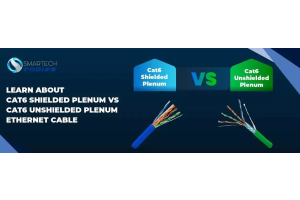Top Differences between Bulk Cat6 and Cat6a Cables: Explained

There is hardly anyone who works around the computers and has not heard about the ethernet cables. Cat6 Vs Cat6a carries different roles in the field of computers. With the invention of Wi-Fi, many people thought that these cables would become obsolete but they all were wrong. Even though Wi-Fi is a user-friendly technology, but we cannot deny the importance of ethernet cables.
There are many types of cables available in the market these days. Getting a perfect cable for your network can be quite a task. Each of these cables varies from each other in many aspects. Today we are going to talk about two of the category 6 cable; Cat6 cable and cat6a. These cables differentiate from each other in many aspects not just the “a” in their names. We are going to break down each aspect of these cables to help you understand these cables and make an informed decision about getting a perfect cable for your network. Let’s start, shall we:
Identification:
We’ll start with a simple one; identification. Both cat6 and cat6a have their identifications printed on their jackets. The jacket is the only way to differentiate these cables. Cat6a has a thicker and bulkier jacket than cat6. Both of these cables use the same RJ45 connectors. We cannot identify them based on their connectors. So, if you are getting a cat6a cable makes sure to get the right one.
Wiring Structure:
All the latest networking cables in the market are made of tightly twisted pairs of wire. Both cat6 and Cat6a cable are made of high-quality 23 AWG wire. There is a total of eight wires twisted together in four pairs. There are also eight conductors in total in each of these cables. The data is transmitted through these cables, but the cables' length can get in the way of their performance. The wiring structure is one of the major differences between new and old networking cables.
Cat6 and Cat6a are manufactured according to the latest standards in the cabling industry. Both of these cables meet or exceed the TIA/EIA verified standards. These cables can give you a data transmission speed of up to 10 gigabits per second. The pairs in these cables are of both shielded and unshielded types.
Shielded Vs Unshielded:
As I have mentioned earlier, the internal structure of ethernet cables is made of twisted pairs of wire. These pairs can both be shielded and unshielded. In a shielded twisted pairing structure, there is an aluminum foil around the twisted pairs. This extra layer provides better protection against crosstalk and electromagnetic interferences.
If you are running a giant network and many cables are passing by side by side, sometimes the signals can overlap each other. This phenomenon can be known as crosstalk. The extra layer around the pairs gives cable better protection against crosstalk. Also, the pairs are tightly twisted to avoid crosstalk. In unshielded pairing, there is only a layer in between the pairs. The shielded cables are a bit more expensive than the unshielded ones for obvious reasons.
Performance:
As we know, both cat6 and cat6a have the same amount of speed of data transmission, the difference lies in the frequencies of these cables. Cat6 has a frequency of 550MHz. This is a decent frequency and you can use this cable in giant networks. But if you are looking for something better, you can always go Cat6a. This cable will give you a 650MHz frequency. Cat6a performs well even at longer distances. The difference is between the twisting of the twisted pairs in the cable.
Lengths:
For category 6 cables, maximum lengths entirely depend on the speed of the network and crosstalk. If you are running a low-speed network such as a 10, 100, or 1000-megabit system, the maximum length of cat6 is 100 meters. In these conditions, 90% of the length is used to transmit the data and the rest is used for the connection. But if the network is big and the crosstalk conditions are far from ideal, then this length comes to 33 meters. For cat6a cables, the maximum length is over 100 meters. It is because this cable meets the higher standards.
Jacketing:
There are three types of jackets for both Cat6 and Cat6a. The type of jacket determines the installation conditions for these cables:
Plenum– both cat6 and cat6a come in the plenum jacket. If your cable has a plenum-rated jacket, you can install it in the plenum spaces of your building. These spaces have regular air circulations. Plenum spaces are also more prone to fire. There is a fire-retardant material coating on plenum-rated cables. In the event of a fire, these cables burn slowly with fewer toxic fumes. Both Cat6 plenum and Cat6a Plenum are available in the market.
Riser – if your cable has a riser jacket, you can install it in the non-plenum spaces of your building. These cables are also good for vertical installations. Riser-rated cables are for outdoor installations.
PVC – PVC or polyvinyl chloride is another type of jacket of ethernet cables. These cables have the sturdiness and they are good for installations in extreme conditions. You can use these types of cables in extreme temperatures as well.
Applications:
Both Cat6 and Cat6a have a lot of applications. You can use these Ethernet Cables for the internet, sharing, and file transfer. These cables can also be used on an industrial scale.
Data Centers:
Data centers require the highest level of performance and reliability because they are the most important part of any data network. Cabling for data centers differs from common installations. You can use both Cat6 and Cat6a cables in the data centers because of their reliability and speed. Cat6a plenum, of course, would give you an edge over the cat6, but both cables are good for the data centers. Careful planning and proper specifications will help you ensure a successful installation.
PoE (Power Over Ethernet):
There is certainly high-quality connectivity that is essential for attaining the performance and reliability in PoE. The components for PoE should be able to decrease the temperature and meet the highest industry standards. Both Cat6 and Cat6a can be used for this purpose. There are certain conditions if you are installing cables for power over ethernet.
The temperature could be one of the major issues in PoE because when the power passes through the twisted pair cables, their temperature increases. High temperatures can lead to higher insertion loss, and in turn shorter permissible cable lengths. It can also increase bit error rates, and create higher power costs due to more power dissipated in the cabling. The Telecommunications Industry Association (TIA) recommends 15 degrees Celsius as the maximum allowed temperature rise above ambient as a result of power over the cabling.
If you are looking to buy premium-quality Cat6 Plenum and Cat6a Plenum, you can order them from Smartech Cables.






